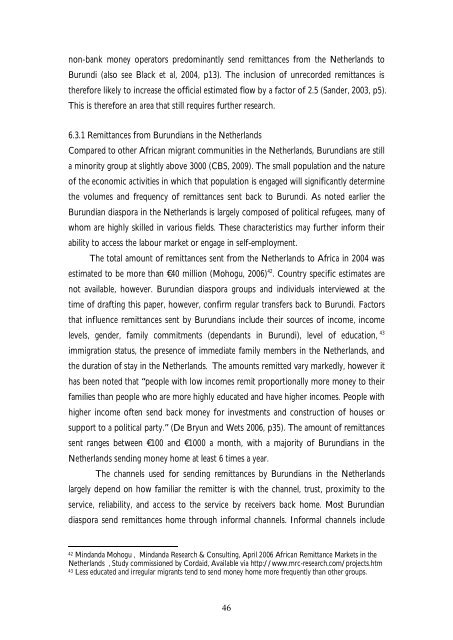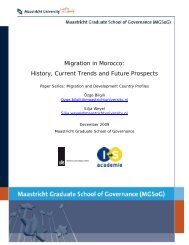Migration in Burundi: History, Current Trends and Future - MGSoG ...
Migration in Burundi: History, Current Trends and Future - MGSoG ...
Migration in Burundi: History, Current Trends and Future - MGSoG ...
Create successful ePaper yourself
Turn your PDF publications into a flip-book with our unique Google optimized e-Paper software.
non-bank money operators predom<strong>in</strong>antly send remittances from the Netherl<strong>and</strong>s to<br />
<strong>Burundi</strong> (also see Black et al, 2004, p13). The <strong>in</strong>clusion of unrecorded remittances is<br />
therefore likely to <strong>in</strong>crease the official estimated flow by a factor of 2.5 (S<strong>and</strong>er, 2003, p5).<br />
This is therefore an area that still requires further research.<br />
6.3.1 Remittances from <strong>Burundi</strong>ans <strong>in</strong> the Netherl<strong>and</strong>s<br />
Compared to other African migrant communities <strong>in</strong> the Netherl<strong>and</strong>s, <strong>Burundi</strong>ans are still<br />
a m<strong>in</strong>ority group at slightly above 3000 (CBS, 2009). The small population <strong>and</strong> the nature<br />
of the economic activities <strong>in</strong> which that population is engaged will significantly determ<strong>in</strong>e<br />
the volumes <strong>and</strong> frequency of remittances sent back to <strong>Burundi</strong>. As noted earlier the<br />
<strong>Burundi</strong>an diaspora <strong>in</strong> the Netherl<strong>and</strong>s is largely composed of political refugees, many of<br />
whom are highly skilled <strong>in</strong> various fields. These characteristics may further <strong>in</strong>form their<br />
ability to access the labour market or engage <strong>in</strong> self-employment.<br />
The total amount of remittances sent from the Netherl<strong>and</strong>s to Africa <strong>in</strong> 2004 was<br />
estimated to be more than €40 million (Mohogu, 2006) 42 . Country specific estimates are<br />
not available, however. <strong>Burundi</strong>an diaspora groups <strong>and</strong> <strong>in</strong>dividuals <strong>in</strong>terviewed at the<br />
time of draft<strong>in</strong>g this paper, however, confirm regular transfers back to <strong>Burundi</strong>. Factors<br />
that <strong>in</strong>fluence remittances sent by <strong>Burundi</strong>ans <strong>in</strong>clude their sources of <strong>in</strong>come, <strong>in</strong>come<br />
levels, gender, family commitments (dependants <strong>in</strong> <strong>Burundi</strong>), level of education, 43<br />
immigration status, the presence of immediate family members <strong>in</strong> the Netherl<strong>and</strong>s, <strong>and</strong><br />
the duration of stay <strong>in</strong> the Netherl<strong>and</strong>s. The amounts remitted vary markedly, however it<br />
has been noted that “people with low <strong>in</strong>comes remit proportionally more money to their<br />
families than people who are more highly educated <strong>and</strong> have higher <strong>in</strong>comes. People with<br />
higher <strong>in</strong>come often send back money for <strong>in</strong>vestments <strong>and</strong> construction of houses or<br />
support to a political party.” (De Bryun <strong>and</strong> Wets 2006, p35). The amount of remittances<br />
sent ranges between €100 <strong>and</strong> €1000 a month, with a majority of <strong>Burundi</strong>ans <strong>in</strong> the<br />
Netherl<strong>and</strong>s send<strong>in</strong>g money home at least 6 times a year.<br />
The channels used for send<strong>in</strong>g remittances by <strong>Burundi</strong>ans <strong>in</strong> the Netherl<strong>and</strong>s<br />
largely depend on how familiar the remitter is with the channel, trust, proximity to the<br />
service, reliability, <strong>and</strong> access to the service by receivers back home. Most <strong>Burundi</strong>an<br />
diaspora send remittances home through <strong>in</strong>formal channels. Informal channels <strong>in</strong>clude<br />
42 M<strong>in</strong>d<strong>and</strong>a Mohogu , M<strong>in</strong>d<strong>and</strong>a Research & Consult<strong>in</strong>g, April 2006 African Remittance Markets <strong>in</strong> the<br />
Netherl<strong>and</strong>s , Study commissioned by Cordaid, Available via http://www.mrc-research.com/projects.htm<br />
43 Less educated <strong>and</strong> irregular migrants tend to send money home more frequently than other groups.<br />
46



